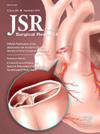评估美国社会脆弱性与心脏移植结果之间的关联。
IF 1.7
3区 医学
Q2 SURGERY
引用次数: 0
摘要
导言:社会脆弱性指数(SVI)是由美国疾病控制和预防中心开发的一种工具,用于帮助识别因社会、经济或环境因素而面临伤害风险的社区。本研究评估了 SVI 与美国成人心脏移植(HT)结果之间的关联:方法:使用器官共享联合网络登记册识别 2010 年至 2021 年间所有孤立的成人(≥18 岁)心脏移植受者及其家庭住址邮编。受者被分为三个 SVI 风险组:低风险组(SVI.A)、高风险组(SVI.B)和高风险组(SVI.C):结果:共纳入了分布在 9753 个邮政编码中的 22,400 名受试者。三个风险组未经调整的 1 年生存率如下:低风险:90.5%,中度风险:91.1%,高度风险:90.9%,Log-rank P = 0.550;5 年生存率如下:低风险:80.8%,中度风险:78.6%,高度风险:76.1%,Log-rank P 结论:社会脆弱性与高血压结果相关:社会脆弱性与高血压结果相关。美国疾病控制和预防中心的 SVI 可能是一个有用的工具,可用于识别高风险地区,在这些地区开展有针对性的工作可能会有助于减少高血压预后的差异。本文章由计算机程序翻译,如有差异,请以英文原文为准。
Evaluating the Association Between Social Vulnerability and Outcomes of Heart Transplantation in the United States
Introduction
The Social Vulnerability Index (SVI) is a tool that was developed by the Centers for Disease Control and Prevention to help identify communities that are at risk of harm from social, economic, or environmental factors. This study evaluates the association between SVI and outcomes of adult heart transplantation (HT) in the United States.
Methods
The United Network for Organ Sharing registry was used to identify all isolated adult (≥18 y) HT recipients and their home address zip codes between 2010 and 2021. Recipients were classified into three SVI risk groups: low risk (SVI: <0.33), intermediate risk (SVI: 0.33-0.65), and high risk (SVI: ≥0.66). Kaplan–Meier analysis was used to estimate recipient survival probability based on SVI risk. Multivariable Cox proportional hazard models were built to evaluate the association of SVI with 1- and 5-y mortality.
Results
A total of 22,400 recipients distributed over 9753 zip codes were included. Unadjusted 1-y survival rates in the three risk groups were as follows: low risk: 90.5%, intermediate risk: 91.1%, high risk 90.9%, and Log-rank P = 0.550 and 5-y survival rates were as follows: low risk: 80.8%, intermediate risk: 78.6%, high risk: 76.1%, and Log-rank P < 0.001. Compared to low-risk recipients, risk-adjusted 1-y mortality hazard ratio was 1.02 (0.92-1.14, P = 0.657) for intermediate risk and 1.09 (0.95-1.24, P = 0.222) for high-risk recipients. Risk-adjusted 5-y mortality hazard ratio was 1.07 (0.99-1.16, P = 0.095) for intermediate-risk recipients and 1.17 (1.06-1.28, P = 0.002) for high-risk recipients.
Conclusions
Social vulnerability is associated with HT outcomes. The Centers for Disease Control and Prevention SVI may be a useful tool in identifying at-risk geographic areas where targeted efforts may be prudent for reducing disparities in HT outcomes.
求助全文
通过发布文献求助,成功后即可免费获取论文全文。
去求助
来源期刊
CiteScore
3.90
自引率
4.50%
发文量
627
审稿时长
138 days
期刊介绍:
The Journal of Surgical Research: Clinical and Laboratory Investigation publishes original articles concerned with clinical and laboratory investigations relevant to surgical practice and teaching. The journal emphasizes reports of clinical investigations or fundamental research bearing directly on surgical management that will be of general interest to a broad range of surgeons and surgical researchers. The articles presented need not have been the products of surgeons or of surgical laboratories.
The Journal of Surgical Research also features review articles and special articles relating to educational, research, or social issues of interest to the academic surgical community.

 求助内容:
求助内容: 应助结果提醒方式:
应助结果提醒方式:


